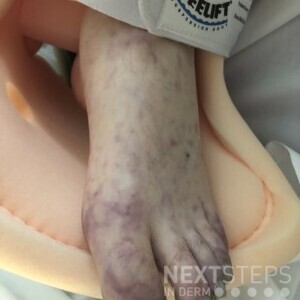
The correct answer is B. Cholesterol Emboli.
The image shows retiform purpura on the distal lower extremity. Given the history of pulmonary arterial emboli along with eosinophilia and AKI, this is most consistent with cholesterol emboli (choice 2). The classic description of this is in a patient who underwent a catheterization but this can also occur after long bone fractures. The showers of emboli result in cholesterol deposition in the distal extremities.
Type II cryoglobulinemia is a vasculitis, not a vasculopathy, and would present with palpable purpura as opposed to retiform purpura (Type I cryoglobulinemia is a true vasculopathy). The patient has no history to suggest warfarin necrosis, and this entity is similar to calciphylaxis in that it affects more central, fatty areas of the body. Henoch Schonlein Purpura generally affects children (or adults with ESRD) and is a vasculitis that manifests with palpable purpura. There is no history of cocaine use to suggest levamisole vasculopathy.
References:
Bolognia, Jean., Jorizzo, Joseph L.Schaffer, Julie V. (Eds.) (2012) Dermatology /[Philadelphia] : Elsevier Saunders
